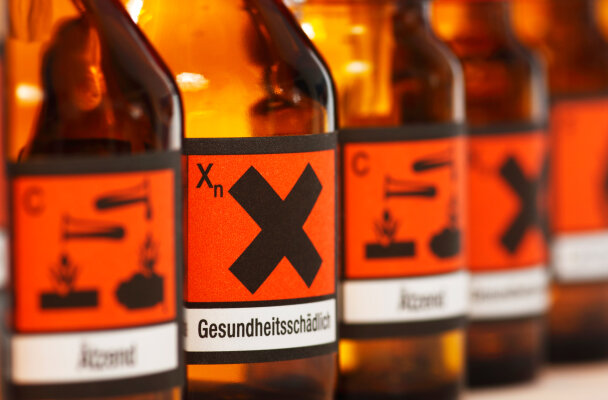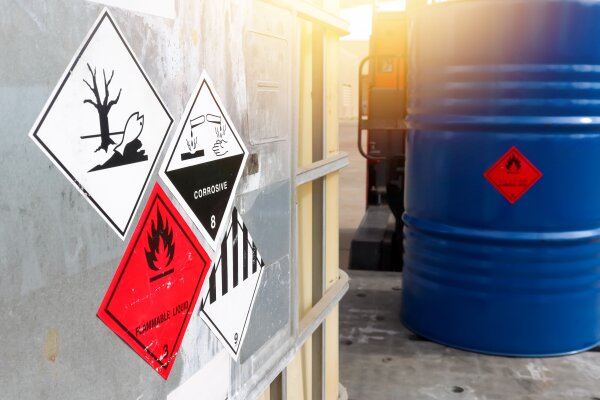What are hazardous substances? Definition and labeling
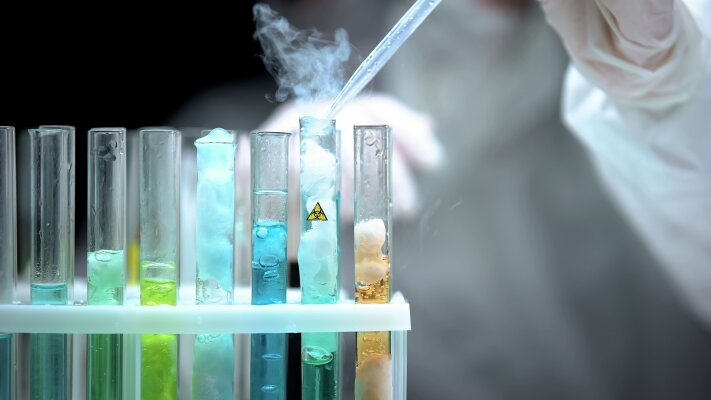
In order to take the right safety precautions when dealing with potentially harmful substances, they must be classified - and classified as hazardous substances. But what are hazardous substances? This blog post provides various definitions of hazardous materials and gives an overview of the potential health effects. The legal regulations, the applicable labeling requirements and protective measures in handling are also briefly described.
What is a hazardous substance: definition
When hazardous substances are mentioned, they are mixtures and substances that can have a harmful effect on the environment and/or humans during manufacture and/or use. This general definition of hazardous substances can also be extended to those substances that exceed a certain limit.
What are hazardous substances within the meaning of the Hazardous Substances Ordinance?
In principle, there are several ways to answer the question "what are hazardous substances?". A good definition is provided by the Ordinance on Hazardous Substances (Gefahrstoffverordnung), which is included in the German occupational health and safety regulations for protection against hazardous substances. The GefStoffV gives the following wording as a definition of hazardous substances and gives the following wording for the five hazard classes:
- Dangerous substances and mixtures according to § 3:This primarily includes substances that are considered "carcinogenic, germ cell mutagenic or toxic for reproduction" or contain such ingredients.
- Substances, mixtures and articles which are explosive: This includes substances that can easily explode. Examples include glycerol trinitrate and picric acid.
- Substances, mixtures and articles from which substances according to number 1 or number 2 are formed or released during manufacture or use:Thus, attention must be paid to the formation of hazardous substances not only in the basic substances, but also in a combination of different ingredients.
- Substances and mixtures that do not meet the criteria set out in numbers 1 to 3 but which, because of their physico-chemical, chemical or toxic properties and the way in which they are present or used in the workplace, may endanger the health and safety of workers: Thus, substances that may have other potentially harmful effects on humans are also considered hazardous substances.
- All substances that have been assigned an occupational exposure limit: For example, if a substance only becomes hazardous above a certain concentration, it must also be considered a hazardous substance according to this definition.
What are hazardous substances as defined by the Chemicals Act?
However, not only the Hazardous Substances Ordinance, but also the Chemicals Act provides a definition of hazardous substances. Hazardous substances and mixtures within the meaning of this Act are dealt with in § 3a. There, reference is made to Regulation (EC) No 1272/2008, which sets out criteria in Annex 1, Parts 2 and 3, and Parts 4 and 5. According to the Chemicals Act, hazardous substances include not only mixtures but also dangerous substances that ...
- ... meet the criteria for physical or health hazards set out in Parts 2 and 3 of Annex Ito Regulation (EC) No 1272/2008; or
- "are dangerous for the environment in that they (a) meet the criteria set out in Annex I, Parts 4 and 5 of Regulation (EC) No 1272/2008 meet the criteria for environmental hazards and other hazards set out in Regulation (EC) No 1272/2008, or (b) are otherwise likely, by themselves or by their transformation products, to alter the state of the natural environment, water, soil or air, climate, animals, plants or micro-organisms in such a way that hazards to the environment may thereby be brought about immediately or subsequently."
Health effects of the hazardous substances
To ensure proper handling of hazardous substances, some regulations on labeling and handling are required by law. And for good reason, because exposure to these substances via various ingestion routes can lead to health hazards.
Recording paths
Hazardous substances can enter the human body via several routes, which is why special care must be taken when handling them. The four recording paths that are officially distinguished are the following:
- Inhalation: If hazardous substances are absorbed into the body by inhalation, this is referred to as inhalation uptake. This primarily affects the nose and relates to hazardous gases, aerosols, dusts and vapors, for example.
- Oral: If, on the other hand, the substance is absorbed through the mouth and enters the body from there, this is an oral intake. This concerns, for example, dusts and liquids as well as the ingestion of solids.
- Dermal:We speak of dermal absorption when the hazardous substance is absorbed by the skin - think, for example, of dusts, vapors and liquids that come into direct contact with the skin.
- Subcutaneous:Finally, there is subcutaneous uptake, in which a foreign body penetrates under the skin. Needlestick injuries are a good example of this.
Possible health hazards
Depending on which hazardous substance is involved, very different health hazards can arise. These range from harmless skin irritations to acute danger to life. For this purpose,Regulation (EC) No 1272/2008 provides a list in which the following hazards have been included:
- Acute toxicity (point 3.1.)
- Corrosive/irritant effect on skin (point 3.2.)
- Serious eye damage/eye irritation (point 3.3.)
- Sensitization of the respiratory tract or skin (point 3.4.)
- Germ cell mutagenicity (point 3.5.)
- Carcinogenicity (point 3.6.)
- Reproductive toxicity (point 3.7.)
- Specific target organ toxicity (point 3.8. and 3.9.)
- Aspiration hazard (point 3.10.)
Legal regulations regarding hazardous substances
Several legal regulations apply to the handling of hazardous substances, relating to both hazardous substance labeling, storage of hazardous substances, protective regulations and requirements for employers. In particular, the following legal texts and regulations should be taken into account:
- Hazardous substances legislation:This regulates activities involving hazardous substances. It is differentiated into the general hazardous substances legislation chemicals legislation and the special hazardous substances legislation (such as plant protection legislation and food legislation).
- Hazardous Substances Ordinance: This forms the legal basis for protective measures for employees and provides a common definition of hazardous substances.
- European Hazardous Substances Directives: These include several regulations that apply within the EU member states and are transposed into national law.
Hazardous substance: The mandatory labeling
The Globally Harmonized System (GHS)provides the basis for the classification and labeling of chemicals. It is harmonized with regard to the regulations for dangerous substances and goods and has been approved by the United Nations. This makes it possible to achieve global harmonization of labeling, which also facilitates transport. According to the GHS, the labeling should be as follows:
| Pictogram | Coding | Signal word | Examples |
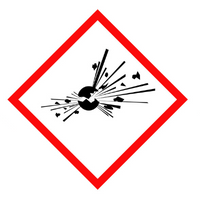 |
GHS01 - Explosive substances | Danger | unstable explosive substances,spontaneously combustible substances |
 |
GHS02 - Flammable substances and mixtures | Caution or danger | flammable, pyrophoric, self-heating gases |
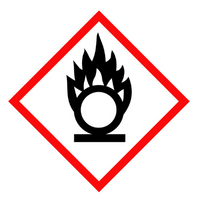 |
GHS03 - Flammable and oxidizing substances and mixtures | Danger | Inflammatory (oxidizing) action |
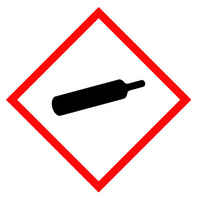 |
GHS04 - Pressurized gases | Caution | Gases under pressure, compressed, liquefied, dissolved gases |
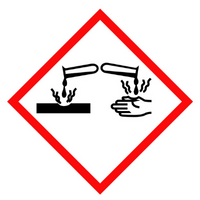 |
GHS05 - Substances which are corrosive to skin, harmful to eyes and harmful to metals. | Caution or danger | Metal corrosive substances |
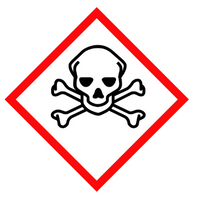 |
GHS06 - Acutely toxic substances | Caution or danger | Acute toxicity |
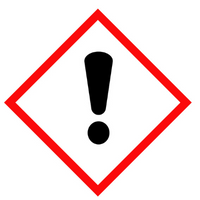 |
GHS07 - Health hazard | Caution | skin irritant, eye irritant |
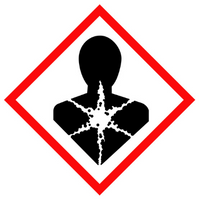 |
GHS08 - Systemic health hazards | Caution or danger | various health hazards, e.g. harmful to skin, lungs and eyes |
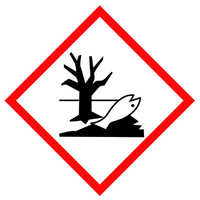 |
GHS09 - Environmentally hazardous to the aquatic environment | Caution or without signal word | hazardous to the environment and water |
Protective measures against hazardous substances
Not only the recognition, labeling and storage of hazardous substances, but also appropriate protective measures and proper hazardous materials management are elementary. These are prescribed in a fixed orderby the legislator and must be observed both in the private sphere and by the employer:
- Avoidance or elimination of sources of danger or potential for exposure:This includes a hazard assessment and a substitute substance test - for example, can a solvent-based paint be replaced with a water-based variant?
- Technical protective measures: Technical protective measures include the use of closed systems and equipment, the extraction of vapors, and the ventilation of work rooms.
- Organizational protective measures: At the top of the list of organizational protective measures are access restrictions as well as quantity limits and measurements of limit values.
- Personal protective measures: This includes in particular protective equipment such as hearing protection and safety goggles.
- Behavioral protective measures: Protective measures can also be undertaken through instruction and training for hazardous substances. There, for example, the differences between hazardous substance and dangerous goods are
Hazardous substances: Good protection in the workplace is mandatory
Since contact with hazardous materials is possible in many forms and situations, care must be taken to ensure appropriate labeling and storage, as well as safe handling. Those who follow the legal regulations and take important protective measures are on the safe side.
Do you have questions about the topic or would you like to suggest a topic? Please feel free to contact us by phone at +49 30 2096579 00 or send us an email to info@medsolut.com.

